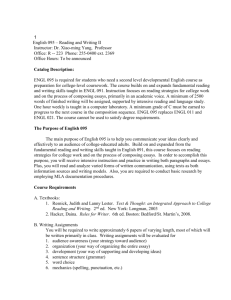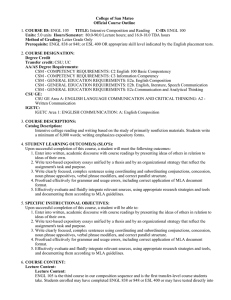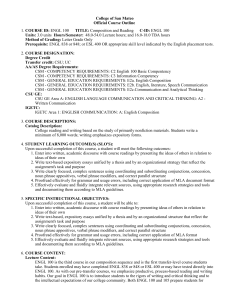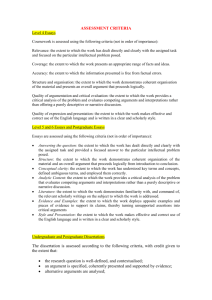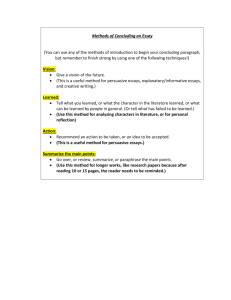College of San Mateo Official Course Outline COURSE ID: Units:
advertisement
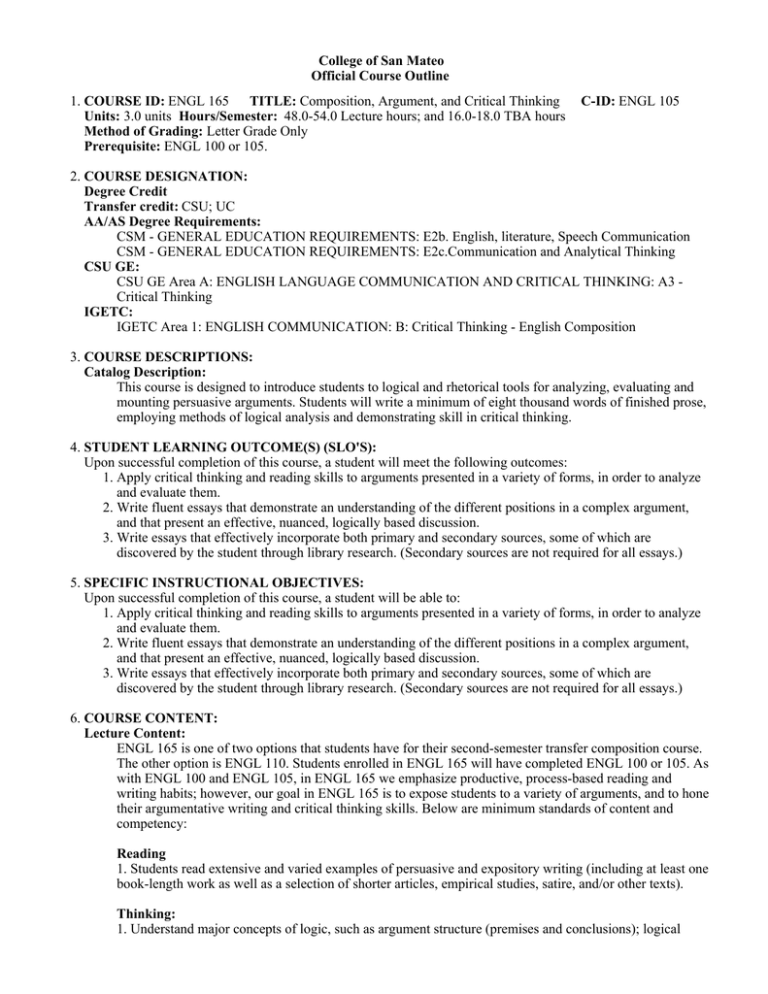
College of San Mateo Official Course Outline 1. COURSE ID: ENGL 165 TITLE: Composition, Argument, and Critical Thinking Units: 3.0 units Hours/Semester: 48.0-54.0 Lecture hours; and 16.0-18.0 TBA hours Method of Grading: Letter Grade Only Prerequisite: ENGL 100 or 105. C-ID: ENGL 105 2. COURSE DESIGNATION: Degree Credit Transfer credit: CSU; UC AA/AS Degree Requirements: CSM - GENERAL EDUCATION REQUIREMENTS: E2b. English, literature, Speech Communication CSM - GENERAL EDUCATION REQUIREMENTS: E2c.Communication and Analytical Thinking CSU GE: CSU GE Area A: ENGLISH LANGUAGE COMMUNICATION AND CRITICAL THINKING: A3 Critical Thinking IGETC: IGETC Area 1: ENGLISH COMMUNICATION: B: Critical Thinking - English Composition 3. COURSE DESCRIPTIONS: Catalog Description: This course is designed to introduce students to logical and rhetorical tools for analyzing, evaluating and mounting persuasive arguments. Students will write a minimum of eight thousand words of finished prose, employing methods of logical analysis and demonstrating skill in critical thinking. 4. STUDENT LEARNING OUTCOME(S) (SLO'S): Upon successful completion of this course, a student will meet the following outcomes: 1. Apply critical thinking and reading skills to arguments presented in a variety of forms, in order to analyze and evaluate them. 2. Write fluent essays that demonstrate an understanding of the different positions in a complex argument, and that present an effective, nuanced, logically based discussion. 3. Write essays that effectively incorporate both primary and secondary sources, some of which are discovered by the student through library research. (Secondary sources are not required for all essays.) 5. SPECIFIC INSTRUCTIONAL OBJECTIVES: Upon successful completion of this course, a student will be able to: 1. Apply critical thinking and reading skills to arguments presented in a variety of forms, in order to analyze and evaluate them. 2. Write fluent essays that demonstrate an understanding of the different positions in a complex argument, and that present an effective, nuanced, logically based discussion. 3. Write essays that effectively incorporate both primary and secondary sources, some of which are discovered by the student through library research. (Secondary sources are not required for all essays.) 6. COURSE CONTENT: Lecture Content: ENGL 165 is one of two options that students have for their second-semester transfer composition course. The other option is ENGL 110. Students enrolled in ENGL 165 will have completed ENGL 100 or 105. As with ENGL 100 and ENGL 105, in ENGL 165 we emphasize productive, process-based reading and writing habits; however, our goal in ENGL 165 is to expose students to a variety of arguments, and to hone their argumentative writing and critical thinking skills. Below are minimum standards of content and competency: Reading 1. Students read extensive and varied examples of persuasive and expository writing (including at least one book-length work as well as a selection of shorter articles, empirical studies, satire, and/or other texts). Thinking: 1. Understand major concepts of logic, such as argument structure (premises and conclusions); logical method (deduction and induction); common sources of error (fallacies); the distinction between the method (deduction and induction); common sources of error (fallacies); the distinction between the objective and the subjective (fact, inference and judgment). 2. Analyze and evaluate examples of persuasive rhetoric (mostly written, but possibly including documentaries and/or advertising) using logical concepts to identify weaknesses and strengths in arguments. 3. Develop a logical, rhetorically effective argument. 4. Identify the specific ways in which logic develops our ability to think critically about the world and ourselves. Writing: 1. Write 4 to 6 text-based essays, of at least 4 pages each, for a minimum total of 8,000 words of finished prose. 2. The emphasis should be on process-based, out-of-class writing rather than timed, in-class writing and on academic, inquiry-based assignments rather than personal or merely descriptive narrative or summary. Students should not be assigned formulaic writing, such as the five-paragraph essay. 3. Write effectively organized essays with an introduction and a main idea (thesis); body paragraphs that are unified by effective topic sentences and are directly related to the main idea; and a conclusion that moves beyond summarizing the thesis and primary supporting points. 4. Write thoughtful, reasonable and insightful arguments and evaluations of arguments, based on assigned readings and other materials. 5. Write essays in which the evidence offered is sufficient and convincing. Evidence is analyzed, discussed and evaluated, not simply dropped into the essay. 6. Use basic library research to gather and evaluate relevant evidence in support of argument. Lab Content: No lab content. TBA Hours Content: English 165 has a TBA [To Be Arranged Hours] requirement. These TBA hours are instructional activities designed to help improve students' reading and writing skills. Students are required to complete the activities in the Writing Center (18-104), and to log in and out of the attendance tracking system every time they work on one of the activities. Activities include orientations, one-on-one conferences with English instructors, tutorials on specific writing and critical thinking skills, and group workshops. 7. REPRESENTATIVE METHODS OF INSTRUCTION: Typical methods of instruction may include: A. Lecture B. Activity C. Critique D. Directed Study E. Discussion F. Guest Speakers G. Individualized Instruction H. Observation and Demonstration I. Service Learning J. Other (Specify): Other (Specify): Methods should include the following: 1. Building community in the classroom: create a sense of community in the classroom to promote student investment in the course and to build students' confidence. 2. Creating collaborative, student-centered classrooms 3. Inductive rather than prescriptive teaching when appropriate: encourage and help students to reach their own conclusions and to make decisions about their writing rather than direct them explicitly 4. Schema building: help students recognize and build upon their prior knowledge in order to contextualize assigned readings 5. Structured whole-class discussion: help students understand assigned course material and build critical thinking strategies through instructor-guided discussion of course readings and writing assignments 6. Scaffolding of analysis and interpretation: guide students through the steps necessary to evaluate arguments 7. Modeling: use models of student and professional writing to introduce, teach and reinforce effective writing strategies 8. Individual instruction: one-on-one student-teacher conferences 9. Peer review workshops: students share and critique each other’s writing 10. Lecture: provide relevant or necessary background information for writing assignments; explain reading strategies and principles of clear, effective writing. 8. REPRESENTATIVE ASSIGNMENTS Representative assignments in this course may include, but are not limited to the following: Writing Assignments: Written essays (a minimum of 8,000 words) to demonstrate an understanding of course material and the writing process. Journal writing, summaries, and other responses to assigned readings to demonstrate understanding of forms of written argument and synthesize readings. Please see attached files. Reading Assignments: Students read extensive and varied examples of persuasive and expository writing (including at least one book-length work as well as a selection of shorter articles, empirical studies, satire, and other texts). To be Arranged Assignments: Assignments -- which must be completed in the Writing Center -- include orientations, one-on-one conferences with English instructors, tutorials on specific writing and critical thinking skills, and group workshops. 9. REPRESENTATIVE METHODS OF EVALUATION Representative methods of evaluation may include: A. Class Participation B. Class Work C. Exams/Tests D. Group Projects E. Homework F. Papers G. Portfolios H. Projects I. Quizzes J. Research Projects K. Written examination L. **ESSAYS SHOULD CONSTITUTE AT LEAST 80% OF THE FINAL COURSE GRADE. 10. REPRESENTATIVE TEXT(S): Possible textbooks include: A. Rosemary Patton and Sheila Cooper.. Writing Logically, Thinking Critically, 7th ed. Longman, 2011 B. Sylvan Barnet and Hugo Bedau. Current Issues and Enduring Questions, 10th ed. Bedford St. Martins, 2014 C. Andrea Lunsford, John Ruszkiewicz, Keith Walters. Everything's An Argument, 6th ed. Bedford St. Martins, 2013 Other: A. Instructors can also use book-length arguments, or texts that raise questions for logical discussion, analysis and/or evaluation, or that illustrate principles of rhetoric or logic. A very few examples: Harris, Judith Rich. The Nurture Assumption. Free Press: 2009. Krakauer, Jon. Into the Wild. Anchor: 1997. Ozeki, Ruth. My Year Of Meats. Penguin: 1999. Ravitch, Diane. The Death and Life of the Great American School System. Basic Books: 2011. Schulz, Kathryn. Being Wrong. Ecco: 2011. Swift, Jonathan. A Modest Proposal. [Numerous editions.] King, Martin Luther, Jr. The Strength to Love. Fortress Press: 2010. Origination Date: January 2014 Curriculum Committee Approval Date: January 2015 Effective Term: Fall 2015 Course Originator: Katherine James
